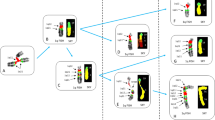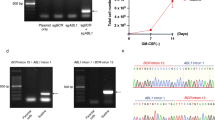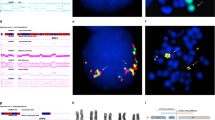Abstract
Several unusual chromosome structures have been described in drug-resistant cell lines and in certain tumours. These structures include elongated homogeneously staining regions (HSRs), small extrachromosomal paired chromatin bodies (double minutes, DMs) and abnormally banded regions (ABRs) with strong but anomalous band patterns1–3. There is evidence that these are alternative forms of gene amplification, with HSRs breaking down to form DMs, and DMs integrating into the chromosome to generate HSRs and ABRs5–7. Recently, it was demonstrated that, compared with several normal leukaemia human cells, DNA sequences representing the human homologue of the onc gene of the avian myelocytomatosis virus (MC29), the so-called c-myc gene, were amplified in HL-60 cells11,12. This is a human pro-myelocytic leukaemia cell line established in the laboratory of one of us (R.C.G.) at the National Cancer Institute (Bethesda, Maryland) in 1977, and widely used for studies on myeloid and monocytic differentiation8–10. Amplification of the gene was present in primary leukaemic cells of the patient12, and DMs were noted in some of these cells as well as in early passages of the HL-60 line13. No structure resembling HSRs or ABRs were noted in karyotypic studies at this early stage13 and there were no alterations involving the long arm of chromosome 8 (8q), to which the c-myc gene has recently been mapped14–16. We have now re-examined the karyotype of the HL-60 line, using cells frozen at various times during its continuous passage at the Wistar Institute (Philadelphia, Pennysylvania) to look for chromosomal abnormalities that might be associated with the amplification of c-myc. We find that, beginning in 1979, HL-60 cells at the Wistar Institute no longer had DMs, but did show an abnormal 8q+ chromosome, replacing a normal chromosome 8, and representing an ABR reflecting the site of myc gene amplification.
This is a preview of subscription content, access via your institution
Access options
Subscribe to this journal
Receive 51 print issues and online access
$199.00 per year
only $3.90 per issue
Buy this article
- Purchase on Springer Link
- Instant access to full article PDF
Prices may be subject to local taxes which are calculated during checkout
Similar content being viewed by others
References
Biedler, J., Henson, L. & Spengler, B. Cancer Res. 33, 2643–2652 (1973).
Biedler, J. & Spengler, B. Science 191, 185–187 (1976).
Sandberg, A. A., Sakurai, M. & Holdsworth, R. Cancer 29, 1671–1678 (1972).
Biedler, J., Melera, P. & Spengler, B. Cancer Genet. Cytogenet. 2, 47–60 (1980).
Balaban, G. & Gilbert, F. Science 198, 739–741 (1977).
Levan, A., Levan, G. & Mandahl, N. Cytogenet. Cell Genet. 20, 12–23 (1978).
Kaufman, R., Brown, P. & Schimke, R. Proc. natn. Acad. Sci. U.S.A. 76 5664–5673 (1979).
Collins, S., Gallo, R. & Gallagher, R. Nature 270, 347–349 (1977).
Collins, S., Ruscetti, F., Gallagher, R. & Gallo, R. Proc. natn. Acad. Sci. U.S.A. 75, 2458–2461 (1977).
Rovera, G., Santoli, D. & Damski, C. Proc. natn. Acad. Sci. U.S.A. 76, 2779–2781 (1979).
Collins, S. & Groudine, M. Nature 298, 679–681 (1982).
Dalla-Favera, R., Wong-Staal, F. & Gallo, R. Nature 299, 61–63 (1982).
Gallagher, R. et al. Blood 54, 713–733 (1979).
Dalla-Favera, R. et al. Proc. natn. Acad. Sci. U.S.A. 79, 7824–7827 (1982).
Taub, R. et al. Proc. natn. Acad. Sci. U.S.A. 79, 7837–7841 (1982).
Neel, B. G., Suresh, C. J., Chaganti, R. S. K. & Hayward, W. S. Proc. natn. Acad. Sci. U.S.A. 79, 7842–7846 (1982).
ar-Rushdi, A., Tan, K. & Croce, C. M. Somatic Cell Genet. 8, 151–161 (1982).
Erikson, J., ar-Rushdi, A., Drwinga, H., Nowell, P. & Croce, C. Proc. natn. Acad. Sci. U.S.A. 80, 820–824 (1983).
Biedler, J., Melera, P. & Spengler, B. in Chromosomes and Cancer (eds Rowley, J. & Ultmann, J. ) (Academic, New York, in the press).
Ferrari, A., Testa, J. & Gallagher, R. Am. J. hum. Genet. 33, 62A (1982).
Marcu, K. et al. Proc. natn. Acad. Sci. U.S.A. 80, 519–523 (1983).
Selden, J. R. et al. Proc. natn. Acad. Sci. U.S.A. (in the press).
Alitalo, K., Schwab, M., Lin, C. C., Varmus, H. E. & Bishop, J. M. Proc. natn. Acad. Sci. U.S.A. 80, 1701–1711 (1983).
Author information
Authors and Affiliations
Rights and permissions
About this article
Cite this article
Nowell, P., Finan, J., Dalla Favera, R. et al. Association of amplified oncogene c-myc with an abnormally banded chromosome 8 in a human leukaemia cell line. Nature 306, 494–497 (1983). https://doi.org/10.1038/306494a0
Received:
Accepted:
Issue Date:
DOI: https://doi.org/10.1038/306494a0
This article is cited by
-
Circular RNA-CDR1as acts as the sponge of microRNA-641 to promote osteoarthritis progression
Journal of Inflammation (2020)
-
Cell cycle arrest induced by Pisosterol in HL60 cells with gene amplification
Cell Biology and Toxicology (2009)
-
Non-incidental coamplification of Myc and ERBB2, and Myc and EGFR, in gastric adenocarcinomas
Modern Pathology (2007)
-
Hypothesis: a novel route for immortalization of epithelial cells by Epstein-Barr virus
Oncogene (2002)
-
E2F activity is essential for survival of Myc-overexpressing human cancer cells
Oncogene (2002)
Comments
By submitting a comment you agree to abide by our Terms and Community Guidelines. If you find something abusive or that does not comply with our terms or guidelines please flag it as inappropriate.



